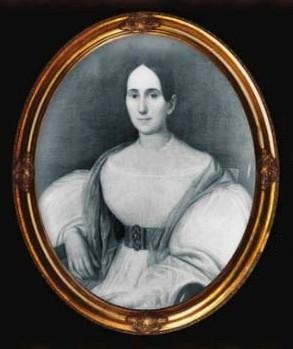At the corner of what is now Royal Street and Governor Nichols Street stands a three-story mansion with a beautifully carved white door and wrought-iron Spanish-style railings around the second story gallery. It is a private home, once owned by Nicolas Cage, and there are no tours offered.
Now why, you might be asking, would someone want to tour this house? Well, I’ll tell you: it is reputed to be one of the most haunted places in New Orleans. Here’s why.
 On April 10, 1834, a fire broke out in the cookhouse of the mansion at the corner of Royal and Hospital streets, which belonged to Doctor Leonard LaLaurie and his wife, Delphine McCarty LaLaurie. Delphine was a wealthy woman, twice widowed, with one grown daughter and two still living at home. Leonard was a young physician who, upon deciding to leave France to seek his fortune in the 1830s, was advised by his father to marry a woman of means — which he did. The McCarty family owned significant tracts of land outside of New Orleans proper; Andrew Jackson stayed at their home during the Battle of New Orleans due to its proximity to Chalmette.
On April 10, 1834, a fire broke out in the cookhouse of the mansion at the corner of Royal and Hospital streets, which belonged to Doctor Leonard LaLaurie and his wife, Delphine McCarty LaLaurie. Delphine was a wealthy woman, twice widowed, with one grown daughter and two still living at home. Leonard was a young physician who, upon deciding to leave France to seek his fortune in the 1830s, was advised by his father to marry a woman of means — which he did. The McCarty family owned significant tracts of land outside of New Orleans proper; Andrew Jackson stayed at their home during the Battle of New Orleans due to its proximity to Chalmette.
Leonard arrived in New Orleans advertising himself as an orthopedist of sorts, claiming he had the ability to “cure hunchbacks.” Delphine was delighted to be the wife of a well-to-do physician who was at least 10 years younger than herself.
 Anyway, kitchens were separate from houses for safety reasons in those days and there was great fear that the flames might spread to the two-story mansion itself. Leonard and Delphine were busily loading their belongings into coaches and wagons rather than attending to the flames, according to the account of Judge J.F. Canonge, who was one of the first on the scene. He heard cries for help, but was overwhelmed by the smoke and flames coming from the building. He helped organize a bucket brigade and, when the fire was somewhat under control, his clerk Amedée Ducatel entered the building … which resulted in one of the most horrifying sights New Orleanians had seen to date.
Anyway, kitchens were separate from houses for safety reasons in those days and there was great fear that the flames might spread to the two-story mansion itself. Leonard and Delphine were busily loading their belongings into coaches and wagons rather than attending to the flames, according to the account of Judge J.F. Canonge, who was one of the first on the scene. He heard cries for help, but was overwhelmed by the smoke and flames coming from the building. He helped organize a bucket brigade and, when the fire was somewhat under control, his clerk Amedée Ducatel entered the building … which resulted in one of the most horrifying sights New Orleanians had seen to date.
Ducatel and the other men eventually brought out a total of seven slaves in such alarmingly bad condition that even slave owners were shocked. Most of them were in a severe state of starvation. Their bodies showed evidence of having been bound, and some of them had bones broken in ways that indicated they may have been Leonard’s test cases on his back straightening machine.
The slaves were half-carried to the Cabildo so that they could get medical treatment. While all of this was going on, Leonard and Delphine continued loading their belongings into the wagons. The citizens and police were horrified, and tried to take the two into custody. They apparently had some pretty fast horses, because they had their coachman gallop them out of town at full speed and eventually the police gave up chase.
The angry citizens of New Orleans broke into the home and wreaked so much havoc that the home was uninhabitable for many years to come. It was eventually rebuilt, with a third story added.
You can read the original report 1834 report about the fire in the New Orleans Bee at this link.
Legends sprang up that Madame LaLaurie had buried tortured slaves in the courtyard, whipped one small child until she leaped from the roof to save herself, and more. These are entirely apocryphal. What we do know, from historical records, is that slaves were taken from her because of abuse; New Orleans’ Code Noir had very strict requirements for humane treatment of slaves, and Delphine fell way short. The slaves were bought by relatives and given back to her, but the record for cruelty remains.
If you would like to know more about the LaLaurie fire, or the family, I highly recommend Caroline Morrow Long’s Madame LaLaurie: Mistress of the Haunted House.
(Photos of the LaLaurie mansion taken by the author. Delphine LaLaurie portrait in the public domain, via WikiMedia Commons.)




Visiting from A to Z – I have an interest in the Civil War, and this story intrigued me greatly. I had never heard of the Code Noir so I did a little checking and found that it was adopted from a French code that originated around 1685. I read some of the code that applied in Louisiana prior to its purchase by the United States in 1803 – slaves could only be Roman Catholic, couldn’t be forced into marriage against their will (how much was that enforced, I wonder?) and could be executed for hitting their masters and leaving a bruise or drawing blood on the face, among other things. It was fascinating reading.
LikeLike
Yep. It also specified that slaves were to be treated humanely (although what this meant was subject to interpretation), and given time off on Sundays. There was a complicating factor in that there was a thriving culture of free people of color in the French Quarter … but all of those laws kind of went out the window the moment a person of color, free or slave, stepped across Canal Street into the American district.
Thanks for stopping by!
LikeLike
When I was in New Orleans, we did go on one of the Historical Hauntings tour and we spent a long time in front of this mansion hearing the horrific story.
I do love reading news articles from the past. They often do not hold anything back.
I always wonder what came of the family after they disappeared so quickly. where would they have gone? How would they have managed to allude capture?
Once Upon a Time
LikeLike
According to Long’s book, they managed to get away as far as Bayou St. John and from there went by boat to France, where they wound up living with Leonard’s family. They all remained in France until their deaths. Delphine’s body was eventually moved from a Paris cemetery to St. Louis No. 1. More information here: https://www.findagrave.com/cgi-bin/fg.cgi?page=gr&GRid=69748516
LikeLike
Oh wow! No wonder they were so focused on loading their things up; they knew what people would find when someone bothered to put out the flames. And, if there are ghosts, there ought to be some at this place. What ghosts sightings have there been? Are they still seen, or has the place gone all quiet?
LikeLike
The legends have it that workmen found dozens of skeletons under the floorboards … and that overnight guests frequently hear screams. The main thing that seems to happen is that people who own the building lose their fortunes. Over time, it was a private school, a furniture shop with living quarters above … and, most frequently a private dwelling. In every single case, the owners lost their money — including Nicolas Cage, who had to sell it during his bankruptcy proceedings. The current owner is a venture capitalist; I don’t think he’ll be losing it all any time soon.
Thanks for stopping by!
LikeLike